IDEX Online Research: Jewelry Stocks Up in Third Quarter
October 10, 06
There’s an old saying on Wall Street: “A rising tide lifts all ships.” That’s what happened with the jewelry stocks in the third quarter of 2006. With virtually every major global market showing solid advances, jewelry stocks floated higher with the markets.
Why do we attribute so much of the third quarter jewelry stock performance to rising stock markets, rather than improving company fundamentals? By traditional financial measures, jewelers’ results were disappointing, and the near term outlook is uncertain. Jewelers delivered disappointing profits in the third quarter. Further, sales and earnings in the all-important fourth quarter will be under pressure due to two factors: higher costs of goods due to hefty commodity price increases, and competition for consumers’ discretionary spending in an environment of high energy prices.
Despite the weak fundamentals of the jewelry industry – at least, as perceived by Wall Street – every portfolio of jewelry stocks, including retailers, online merchants, and suppliers, rose in value, as the graph below illustrates.
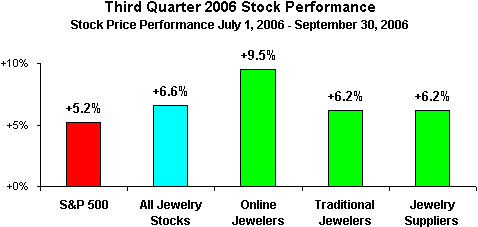
Source: Stock market
Investor Sentiment Turned Positive in Third Quarter
Third quarter performance represented a dramatic turn-around from the second quarter when both the S&P 500 and jewelry stocks fell. At that time, “uncertainty” was cited as the key reason for the sharp decline in stock prices. The market “uncertainty” has now been largely resolved, and the future is much more certain, in the eyes of investors. As a result, the stock market showed a solid gain in the third quarter.
There were several factors fueling a market rebound in the third calendar quarter of 2006, including the following:
- Short term uncertainties resolved – Earlier in the year, investor uncertainties – Wall Street calls these uncertainties a “wall of worry” – were at very high levels. Those uncertainties included the following:
- Energy prices – Oil and gas prices rose to a pinnacle in July, and then began to retreat.
- Geopolitical stresses – Israel and Lebanon tangled in the Middle East, but achieved a cease-fire (uneasy as it may be) in August.
- Economic growth slowing – Investors saw the prospects of a slowing global economy, but could not quantify it. Now, most forecasters call for a slowdown in 2007, with a recovery in 2008.
- Hard vs. soft landing – Most investors now believe that the global economy – especially the U.S. economy – will achieve a soft landing.
- Interest rates – It appears that interest rates are at or near their peak in most of the world’s major economies. As interest rates move lower over the next twelve months, economic growth will be stimulated.
- The environment – In particular, it turns out that the 2006 hurricane and typhoon season was much milder than many had predicted. As a result, there are far fewer business and personal dislocations and disruptions than Wall Street had anticipated.
- Long term outlook more positive – Many of the short term uncertainties that turned positive will also have a favorable impact on the longer term global outlook. Factors fueling a more positive long term outlook include the following:
- Profit recovery prospects – Investors can now see past the short term negative factors, and they believe that the longer term future looks brighter for corporate financials.
- Geopolitical stresses abating – Despite challenges related to Iran and Iraq, many of the world’s geopolitical areas reached a breaking point in the second quarter. With those stresses relieved – somewhat like an earthquake – it is unlikely that those stress levels will rise sharply near term.
- Oil prices moderating – Politics and demand have driven down oil prices in the past few months. Short of a one-time cataclysmic event, it is unlikely that oil prices will turn sharply higher near term.
- China – The government has begun to let the Chinese yuan drift; further, top officials say they are trying to rein in potentially run-away economic growth in that country.
Year-to-Date Stock Performance Disappointing for Jewelers
Unfortunately, a quirk of mathematics yielded disappointing performance for jewelry stocks. While the S&P 500 has gained 7 percent for the year, the IDEX Online Portfolio of all jewelry stocks is down 6 percent.
Why have jewelry stocks under-performed? Jewelry stock prices have been particularly volatile during the year. Through the second quarter, jewelry stocks were down 12 percent while the broad market S&P 500 was up about 2 percent. Unfortunately, the third quarter rebound of nearly 7 percent still left the jewelry stock portfolio down by more than 6 percent. That’s because when stocks drop 12 percent, a 12 percent price recovery does not bring them back to break-even; it takes more than a 12 percent gain to for those stocks to come back to their prior level. Because swings in the S&P 500 were far less volatile, its cumulative gains and losses yielded a gain for the year-to-date. Thus, the jewelry stock portfolio performance is as much a quirk of math as it is a reflection of Wall Street’s view of jewelry stocks.
The graph below summarizes stock performance for the broad market as well as jewelry stocks for the nine months ended September 30, 2006.
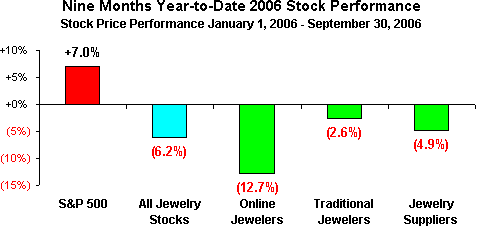
Source: Stock market
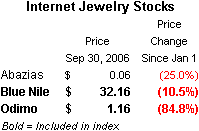
Online Jewelers’ Stocks Up
 |
Thank goodness for Blue Nile: it pushed the IDEX Online Jewelry Portfolio into positive territory. The price of Odimo shares plummeted by more than 80 percent in the quarter. However, because our portfolio consists of 100 shares of each stock, the price gain in total value of Blue Nile shares – up roughly $4 per share – offset the decline of $1 per share in Odimo shares. Odimo will be dropped from the IDEX ONLINE Portfolio, if its share price remains under $1. Since Odimo has sold off its “crown jewel” – the diamond.com domain name and its diamond jewelry business – it is unlikely that ODMO shares will climb above $1 anytime in the near future.
Blue Nile shares tumbled when its sales gains slowed earlier this year; further, Wall Street remains nervous about online stocks. However, Blue Nile appears to be successfully executing a new strategy, and Wall Street has embraced NILE shares once again. Abazias continues to struggle, despite putting on a happy face for investors. Near the end of September, Abazias completed a 1-for-40 reverse stock split; its stock is currently being quoted at $2.40 per share; we have shown the stock price on our table (above) at its pre-split price. If ABZA shares remain above $1, it will be added to our portfolio, probably in 2007. Abazias should not be a public company, in our opinion.
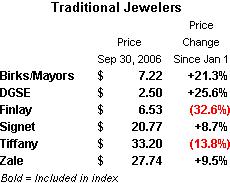
Jewelry Retail Stocks Up
 |
Of the six retail stocks in the IDEX Online Jewelry Portfolio, four posted solid gains in the nine-month year-to-date period, and two stocks are down. While we spent twenty years on Wall Street, we were often baffled by a stock’s performance; that’s the case with these jewelry stocks. Both Tiffany and Signet are well-positioned for the long term, even if growth has slowed near term. However, Wall Street doesn’t seem to understand the power of either brand.
Zale, on the other hand, is still in turmoil, in our opinion, but its stock price is up. While we wish Betsy Burton “best wishes” as she attempts to turn Zale around, we believe it will take longer and cost more than anyone can imagine.
Birks & Mayors continues to post improved financials. As a result, Wall Street investors have rewarded the company with a higher stock price.
Finlay Enterprises continues to close doors faster than it can open new doors or stores; as a result, its growth is negative, a trend that will likely continue for the near term. Finlay is a company that probably should be private, but its financials likely won’t allow that to happen in the foreseeable future.
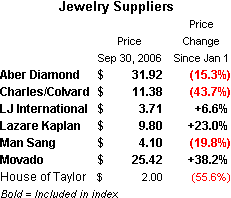
Supplier Stock Prices Up
 |
Stocks of jewelry suppliers rose in the third quarter, but remained below year-ago levels. Charles & Colvard was the laggard of the group; with its higher stock price, it had a greater weighting on the portfolio performance than some of the lower priced stocks. Revenue growth has slowed temporarily for Charles & Colvard; further, management has told Wall Street that it will no longer make forecasts about revenues and profits. Thus, investors have cooled on CTHR shares. Based on our discussions with jewelers, moissanite jewelry is selling well at retail. Given enough time – perhaps six to twelve months, we expect to see the price of CTHR shares rise.
Lazare Kaplan shares continue to rise slowly, fueled by rumors of a buyout (not likely, in our opinion). Movado has generated both strong sales and profit gains, despite a weakening economy; as a result, Wall Street investors have fallen in love with the company and pushed its stock price higher.
Three stocks with low single digit prices – LJ International, House of Taylor, and Man Sang – do not have a high enough price or sufficient trading volume to attract Wall Street’s attention.
Global Luxury Stocks Outperform
As a comparison to the jewelry stock portfolio, IDEX Online maintains an index of ten global luxury stocks, including Burberry, Coach, LVMH, and others. For the nine-month period ended September 30, 2006, this group posted a very strong performance – up nearly 14 percent. Virtually all of this performance came in the third quarter; through the first two quarters of 2006, this luxury group portfolio was flat.
The graph below summarizes performance of the ten-stock IDEX Online luxury group.
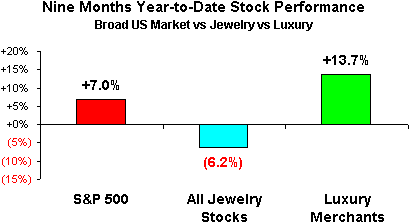
Source: Stock market
Outlook for Jewelers: Mixed
The problem with Wall Street investors is that they say they are long term oriented, but they define “long term” as 15 minutes. Based on Wall Street’s aversion to risk, jewelry stocks could be under pressure until profits recover, perhaps sometime in 2007 as the global economy begins to rebuild.
For savvy investors, however, the time to buy good stocks is when no one else wants them. That’s the opportunity here today, folks.
The author owns 100 or fewer shares of all stocks in the IDEX Online Portfolio.